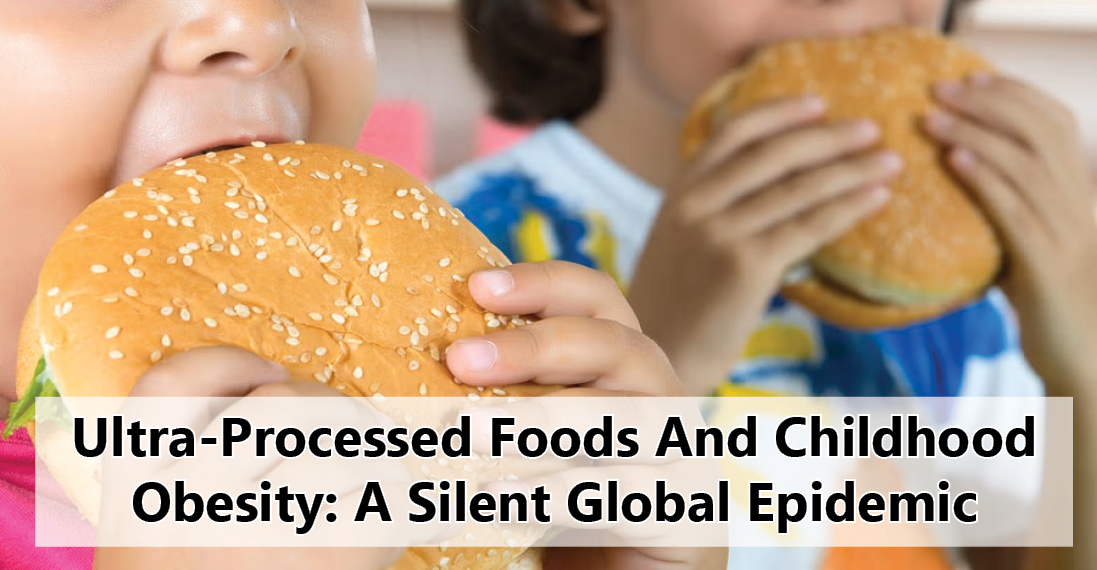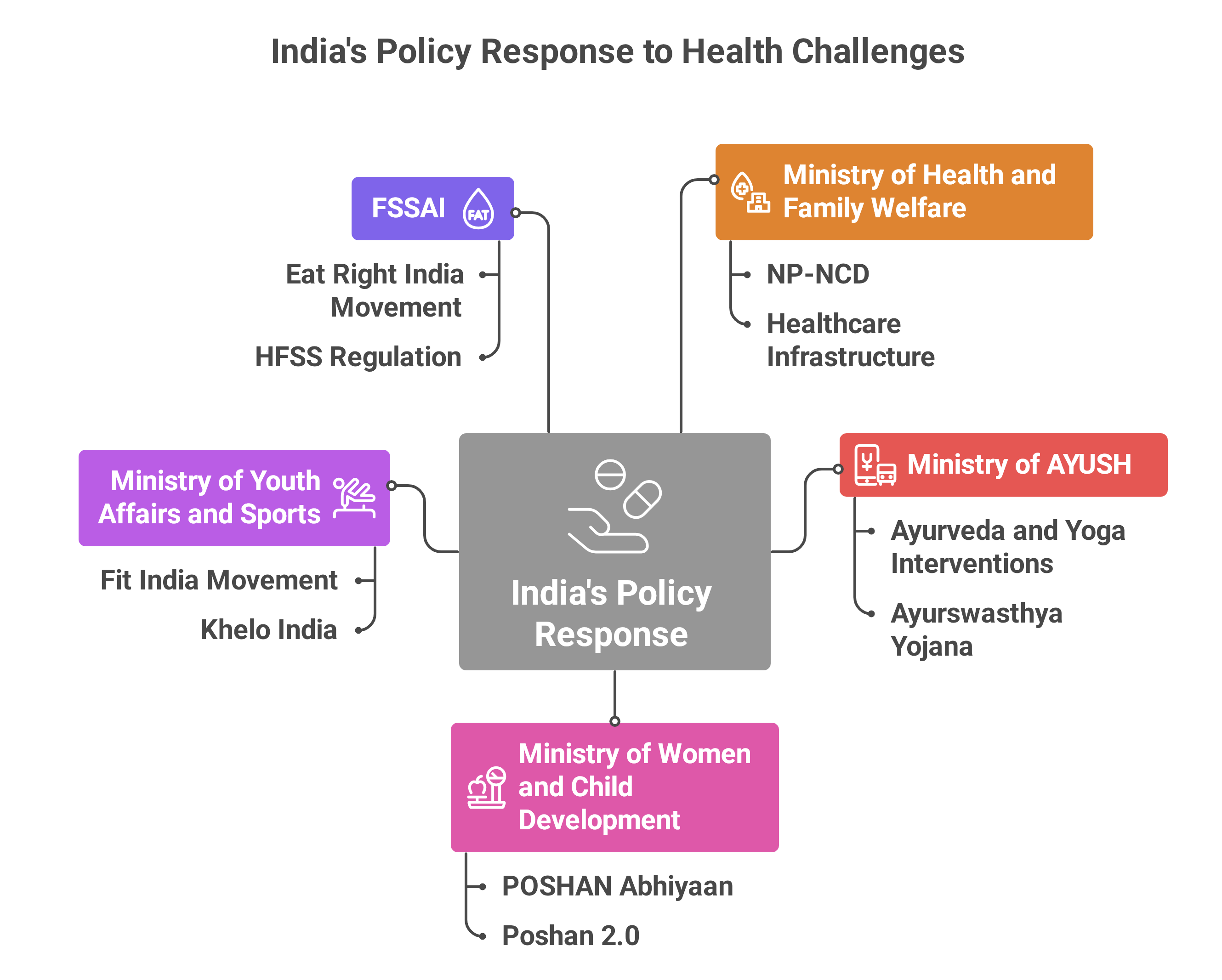Context-
UNICEF has released a major report titled “Feeding Profit: How Food Environments Are Failing Children”, which highlights one of the fastest-growing but least-discussed global health threats: childhood overweight and obesity. For decades, malnutrition was associated mainly with hunger, stunting, and wasting in children. These were visible forms of deprivation caused by lack of access to adequate food.
-
- However, the picture has changed dramatically. Today, more children are carrying excess weight than those suffering from hunger. A key driver of this shift is the increasing dominance of ultra-processed foods (UPFs). These are the products high in sugar, salt, and unhealthy fats, but low in nutritional value. This transformation has not come naturally; it is being pushed by an environment where unhealthy foods are widely available, marketing is aggressive, and regulations are weak allowing these foods to spread quickly into children’s diets.
- The report warns that this “silent epidemic” of obesity could undo years of progress made in child survival and nutrition. It also stresses that the economic costs of this crisis will be massive, as obesity-related illnesses create long-term healthcare burdens for countries.
- However, the picture has changed dramatically. Today, more children are carrying excess weight than those suffering from hunger. A key driver of this shift is the increasing dominance of ultra-processed foods (UPFs). These are the products high in sugar, salt, and unhealthy fats, but low in nutritional value. This transformation has not come naturally; it is being pushed by an environment where unhealthy foods are widely available, marketing is aggressive, and regulations are weak allowing these foods to spread quickly into children’s diets.
Key Findings of the UNICEF Report:
Rising overweight and obesity
· Among children under 5 years, 5% are already overweight.
· Among older children (5–19 years), 20% are overweight, while only 10% are underweight.
· In 2025, obesity (9.4%) overtook underweight (9.2%) for the first time in this age group.
Fastest growth in developing countries
· Since 2000, overweight children and adolescents have doubled, from 194 million to 391 million.
· Over 80% of overweight children now live in low and middle income countries, showing that this is no longer just a “rich world” issue.
Dietary habits
· Many children do not consume fruits, vegetables, or protein-rich foods regularly.
· Instead, their diets are dominated by UPFs such as chips, sugary drinks, packaged snacks, biscuits, and instant noodles.
· Survey findings:
o 60% of adolescents consume sugary foods daily.
o 32% had soft drinks the previous day.
o 25% ate salty processed foods.
Marketing influence
· Junk food advertising has a huge role in shaping children’s choices.
· 3 in 4 young people reported seeing junk food ads within one week.
· Most of these are digital ads, often promoting UPFs with cartoons, celebrities, and influencers, making them especially hard for parents and regulators to track.
Understanding Obesity:
The World Health Organization (WHO) defines obesity as “abnormal or excessive fat accumulation that presents a health risk.”
· Global measure:
o Overweight → BMI ≥ 25
o Obesity → BMI ≥ 30
· India-specific measure:
o Overweight → BMI 23.0 – 24.9
o Obesity → BMI ≥ 25
o Severe obesity → BMI ≥ 35
Global Trends:
· Between 1990 and 2022, obesity among children and adolescents (5–19 years) rose from 2% to 8%.
· In adults, obesity more than doubled during the same period, from 7% to 16%.
This represents a major global shift. Hunger and undernutrition are slowly declining, but obesity is rapidly emerging as the dominant form of malnutrition, creating new challenges for public health systems.
India’s Situation:
India is now facing a double burden of malnutrition. On one hand, many children still suffer from stunting and wasting. On the other, obesity is steadily rising, especially in urban and wealthier households.
· NFHS-5 (2019–21) data:
o 24% of women and 23% of men are overweight or obese.
o Among ages 15–49, 6.4% of women and 4% of men are obese.
· Children under 5 years:
o Overweight prevalence increased from 2.1% in NFHS-4 (2015–16) to 3.4% in NFHS-5 (2019–21).
Even small increases in child overweight percentages are worrying because they can grow rapidly if unchecked.
Why is Childhood Obesity Rising?
1. Food habits
o Many children’s diets are lacking in fruits, vegetables, pulses, and eggs.
o Instead, packaged snacks, fried foods, and sugary drinks dominate daily consumption.
2. Aggressive marketing
o Junk food ads use cartoon characters, sports stars, and influencers to make products attractive.
o The digital shift makes such marketing more personalized and unregulated.
3. Urban lifestyles
o Screen time has gone up significantly.
o Children spend more time indoors, reducing outdoor play and exercise.
4. Economic and social change
o With rising incomes and urbanisation, fast food is cheap, quick, and widely available.
o Traditional, home-cooked meals are being replaced by processed convenience foods.
Consequences of Childhood Obesity:
· Health risks: Higher risk of diabetes, high blood pressure, asthma, cardiovascular disease, liver disorders, and even some cancers.
· Mental well-being: Obesity often leads to low confidence, bullying, body-image issues, and depression in children.
· Economic burden: If trends continue, societies will face trillions of dollars in future healthcare costs.
· Intergenerational impact: Overweight children are more likely to remain obese as adults, passing poor health patterns to the next generation.
India’s Policy Response:
1. Ministry of Health and Family Welfare
· National Programme for Prevention and Control of Non-Communicable Diseases (NP-NCD): Focuses on lifestyle diseases like obesity, diabetes, hypertension, and cancers through screening, early diagnosis, and management.
· Healthcare infrastructure: Includes 682 District NCD Clinics, 191 Cardiac Care Units, and 5,408 CHC NCD Clinics across India.
2. Ministry of AYUSH
· Ayurveda and Yoga interventions: Practices such as Panchakarma therapies, yoga, and traditional diets are promoted for obesity management.
· Over 45,000 patients have benefitted from the All India Institute of Ayurveda.
· Ayurswasthya Yojana: Funds projects targeting obesity, diabetes, and hypertension.
· Collaboration with CSIR to integrate Ayurveda with modern scientific research.
3. Ministry of Women and Child Development
· POSHAN Abhiyaan (2018): Works to improve nutrition for children, adolescents, and mothers.
· Poshan 2.0 (2021):
o Strengthens Anganwadi centres.
o Promotes Poshan Vatikas (nutrition gardens) and millet-based diets.
o Expands use of fortified foods to address micronutrient deficiencies.
4. Ministry of Youth Affairs and Sports
· Fit India Movement (2019): Encourages fitness through cycling, yoga, daily activity, and school certifications.
· Khelo India (2016–17): Expands grassroots sporting culture with infrastructure and training programs.
5. Food Safety and Standards Authority of India (FSSAI)
· Eat Right India Movement: Promotes safe, nutritious, and sustainable diets.
· Campaign “Aaj Se Thoda Kam” urges people to reduce intake of fat, sugar, and salt.
· HFSS Regulation: Mandatory front-of-pack labelling of foods high in fat, salt, and sugar.
· RUCO Initiative: Collects used cooking oil from eateries and converts it into biodiesel, preventing harmful reuse.
Way Forward:
· Stronger regulation: Enforce stricter controls on junk food advertisements, especially on digital platforms.
· Affordable healthy food: Ensure that fresh fruits, vegetables, and protein-rich items are accessible to all sections of society.
· School-based interventions: Integrate nutrition education and daily physical activity into school programs.
· Community awareness: Revive traditional, balanced diets within families and reduce dependence on packaged foods.
· Integration of modern and traditional practices: Combine medical treatments with preventive approaches like yoga and mindfulness for long-term lifestyle change.
Conclusion
The UNICEF report makes it clear: childhood obesity has become a global epidemic. Hunger and undernutrition still exist, but obesity is now overtaking them as the most common form of malnutrition worldwide.
For India, this creates a double challenge: no child should go hungry, but at the same time, rising obesity must be curbed before it spirals out of control.
Unless governments, schools, communities, and families work together, today’s children may grow into adults burdened with lifelong health problems. The fight against childhood obesity is not just about preventing disease—it is about ensuring the future generation is healthy, productive, and capable of contributing to economic and social growth.
| UPSC/PSC Main Question: “Ultra-processed foods (UPFs) are engineered for taste, convenience, and profit, but they erode health and traditional diets.” Discuss this statement in the context of rising childhood obesity in India. |








